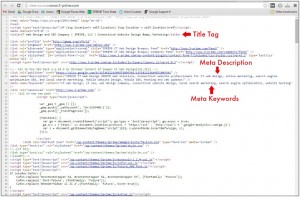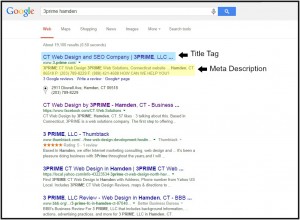Onpage SEO
Meta Tags & How They Work
Posted on .What Are Meta Tags?
Simply put, meta tags are snippets of information, written in HTML, that tell search engines what a page is about. Meta tags cannot be seen on the page itself. Instead, they are visible in a website’s HTML code. You can see this code in a browser by right clicking and then clicking “View page source” on the menu.
Here are different meta tags in 3PRIME’s website:
There are four important types of meta tags:
- Title Tag
- Meta Description
- Meta Keywords
- Meta Robots Attribute
Title Tag & Meta Description
A title tag is similar to the title of a chapter in a book. It simply tells people and search engines what your page is about. Each page on a website must have a title tag, which is most often between 50 and 70 characters (including spaces). A good title tag has the essential keywords without keyword stuffing.
A meta description is a 155 character summary about a page. For a meta description to be good, it should inform a user why he or she should visit a page. Meta descriptions should contain vital keywords, but also avoid keyword stuffing. The best meta descriptions are written for people, not for search engines. If a page has no meta description, the search engine will create one, usually by scraping text from the page.
Here are the title tag and meta description for 3PRIME’s website seen on Google:
Meta Keywords
Meta keywords are a list of 10 to 15 important keywords on your site. The most important keywords usually go at the beginning of the list. Using the MozBar extension for Chrome, you can see the meta keywords for 3PRIME’s website:
Robots Meta Tags
With this type of meta tag, you can tell search engines what exactly to do with a page. The following are examples of some of the more important robot meta tags:
- index/noindex: This robot meta tag tells search engines whether to show your page in search results. This can apply to an entire page or certain elements of it. For example, you can tell a search engine not to index an unimportant (for users, at least) page, like a sitemap. This robot meta tag can also prevent just your website’s images from being indexed.
- follow/nofollow: This robot meta tag tells search engines what to do with links on your pages. Having a nofollow link to an outside site from your website tells a search engine that your website does not endorse this link, thus passing on no SEO boosting value. This is especially used with paid links and blog comments. However, you do want to make sure that all links to your site are follow links.
To learn more about robot meta tags, watch this video.
Meta Keywords, Meta Descriptions, Title Tags, & SEO
Google confirmed in 2009 that they no longer uses meta keywords when it comes to ranking. Much of this was due to spammers abusing the system. As for Yahoo and Bing, experts have concluded that these search engines do take meta keywords into account but their usage in ranking is practically negligible.
As for meta descriptions, experts have concluded that they play a very minor role when it comes to ranking but play a major role when it comes to user experience, especially when it comes to click-through rates.
Unlike the previous two meta tags, title tags are indisputably a very important factor, if not the most, when it comes to relevance and ranking. Bing, Yahoo, and Google are all in agreement about this.




Comments are closed.